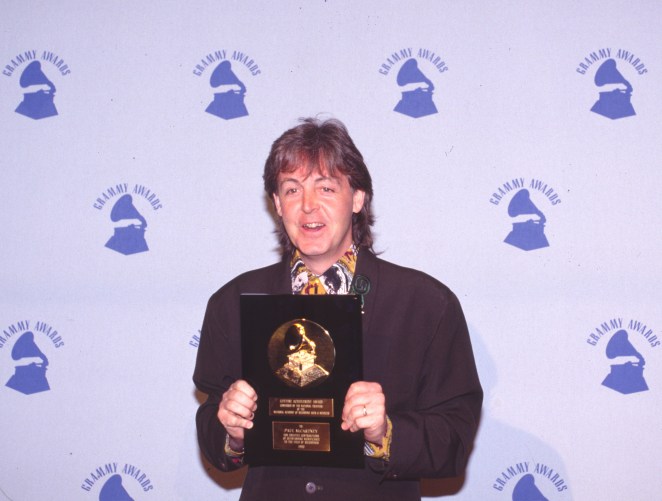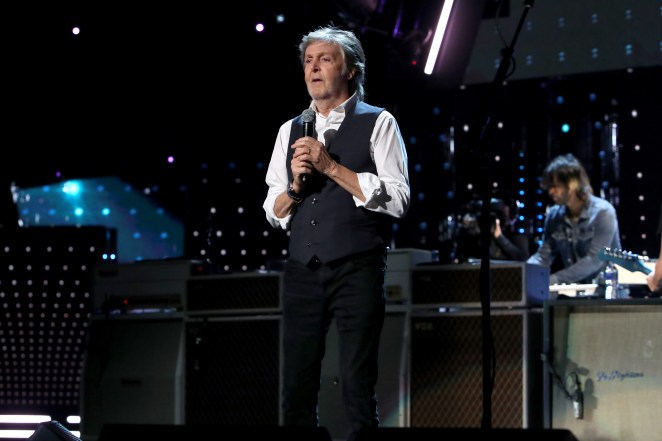Born on June 18, 1942, Paul McCartney is known as one of rock and roll music’s most accomplished artists of all time. From his chaotic rise to fame in The Beatles to crafting an ever-evolving solo career, McCartney has accomplished feats most musicians only dream of.
Videos by American Songwriter
[RELATED: 5 of the Best Love Songs from Paul McCartney]
Along the way, the multi-talented musician has always striven to create powerful art pulled from a vision that’s all his own. Take a look back at influential singer/songwriter Paul McCartney’s personal and creative evolution through the decades.
1960s
At the start of the 1960s, Paul McCartney had already established a close relationship with John Lennon. They became bandmates for the first time in 1961 when McCartney joined Lennon’s band—which had recently been renamed from The Quarrymen to The Beatles—after the departure of bassist Stuart Sutcliffe. Shortly after, the group landed a gig performing backing vocals on a song for rock and roll artist Tony Sheridan. That single made it to the ears of Brian Epstein, whose passion for music and discovering new artists quickly led him to become the band’s manager.
The addition of Epstein and Ringo Starr, who replaced former drummer Pete Best, helped kickstart a career rapid career rise. The year 1963 marked the peak of “Beatlemania,” a pop culture phenomenon that made all four members of The Beatles household names seemingly overnight. McCartney proved his talents as a songwriter early in the band’s career, helping pen trademark hits like “I Want to Hold Your Hand” and “Can’t Buy Me Love.”
It isn’t easy to summarize the true scope and volume of influential music McCartney played a part in during the decade. Together, The Beatles released eleven studio albums in the 1960s. Many of the band’s most recognizable and celebrated hits were co-written by McCartney and Lennon, including “Yesterday,” “Paperback Writer,” “Penny Lane,” and “Hello, Goodbye.” Although the following tracks were formally credited to both artists, McCartney served as the songs’ primary writer and composer.

1970s
In May 1970, The Beatles released what would become their final studio album, Let It Be. The band dissolved after an especially tumultuous period between the members, leading to Lennon’s departure in September 1969. McCartney spent the first months of 1970 at work on his first solo record, McCartney, which was released in April of that year.
The acclaimed project, which includes McCartney’s trademark track “Maybe I’m Amazed,” featured a more intimate, stripped-down sound than the bold, layered production of The Beatles’ final records. McCartney was just the first installment of an extensive line of solo work that continues to this day.
The 1970s also marked the emergence of McCartney’s new band Wings, whose initial lineup included his wife and multi-talented artist Linda on keys, ex-Moody Blues guitarist Denny Laine, and drummer Denny Seiwell. Although the band would go through many lineup changes and sonic shifts over the years, they supplied seven stellar studio albums together through 1979.
1980s
McCartney kicked off the 1980s by releasing his second studio album, McCartney II, which became a massive commercial success. The year 1980 ended in tragedy when Lennon was shot while leaving his apartment in New York City. His death at age 40 sent McCartney into shock, leaving him unable to discuss the loss of his longtime friend and collaborator for many years to come.
Still, McCartney carried on. He spent much of the decade recording solo work and collaborating with modern hitmakers like Michael Jackson and David Bowie. After keeping a firm focus on creating music rather than performing it live, he embarked on a massive world tour in 1989, kicking off a new creative era.

1990s
The 1990s found McCartney exploring new creative pathways, including the creation of his first live orchestral album, released in 1991. Midway through the decade, he stepped away from solo projects to reunite with his former bandmates George Harrison and Ringo Starr. The trio joined forces to help create The Beatles Anthology, a project consisting of a documentary film, multiple career-spanning albums, and a companion book. The film debuted in 1995 as a live televised special, which offered fans interviews and insight into the Beatles’ incredible career journey.
Sadly, the debut of The Beatles Anthology arrived the same year that Linda McCartney was diagnosed with breast cancer. Understandably, Paul redirected his attention to staying by his wife’s side through her treatments. The cancer quickly metastasized, spreading to other parts of her body. Paul was by Linda McCartney’s side when she died on April 17, 1998. She was 56.
A year later, McCartney took the stage at London’s Royal Albert Hall for a benefit concert created in honor of his late wife. The Concert for Linda was a moving, star-studded charity event featuring performances by Elvis Costello, George Michael, The Pretenders, and more.
2000s
McCartney marked the new millennium by dropping two new albums in the year 2000. He experimented with electronica through his collaborative record Liverpool Sound Collage. A Garland for Linda found the hitmaker revisiting his love of orchestral arrangements through this soaring tribute to his beloved wife.
In the hours and days after the September 11 terrorist attacks, McCartney jumped into action. He helped organize The Concert for New York City, a historic benefit concert featuring performances from Elton John, David Bowie, The Rolling Stones’ Mick Jagger and Keith Richards, The Who, John Mellencamp, and more.
The following month, George Harrison died at 58 from lung cancer. Again, McCartney opted to keep creating and performing in the wake of the devastating loss. He spent most of the following year on the road, pausing to exchange vows with model Heather Mills after two years of dating. The pair’s rocky marriage would last until 2008, leading to a headline-making divorce settlement.
Although McCartney weathered some major personal lows during the early 2000s, he also enjoyed some significant career accomplishments. He performed during the 2005 Super Bowl halftime show, broke multiple attendance records with his headlining tours, and released three new albums.

Present Day
This year (2023), McCartney celebrated his 81st birthday. He is among just a handful of acts who have chosen to keep performing, no matter their age. Since 2010, the determined singer/songwriter has maintained a steady presence on the road.
Along with his record-breaking tour schedule, McCartney performed at the Grammy Awards and the Summer Olympics. He recorded hit duets with Rihanna and Kanye West and dropped four more studio albums over the past 13 years. His most recent record, McCartney III, was created during the early months of the COVID-19 pandemic. The project, which marks his eighteenth solo LP, debuted at No. 2 on the Billboard 200 chart upon its release in 2020.
On June 13, 2023, McCartney released 1964: Eyes of the Storm, a book of photographs he took during The Beatles’ early years. He’s currently out on his headlining Got Back Tour, which began in early 2022 and is set to wrap up this December in South America. Before he kicked off the trek, McCartney shared a video documenting the rehearsals for his current tour, which you can watch below.
Photo by Dimitrios Kambouris/Getty Images for The Rock and Roll Hall of Fame
